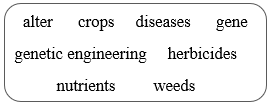Tiếng Anh 8 CLIL Science: Genetic engineering1. Check the meaning of the words in the box. Use the words to complete the text below. 2. Read and listen to the text. Match headings A–E with paragraphs 1–5. 3. Answer the questions. 4. USE IT! Work in pairs. Ask and answer the questions. GÓP Ý HAY - NHẬN NGAY QUÀ CHẤT Gửi góp ý cho HocTot.Nam.Name.Vn và nhận về những phần quà hấp dẫn
Lựa chọn câu để xem lời giải nhanh hơn
Bài 1 I can understand genetic engineering and give my opinion about it. (Tôi có thể hiểu kỹ thuật di truyền và đưa ra ý kiến của mình về nó.) 1. Check the meaning of the words in the box. Use the words to complete the text below. (Kiểm tra nghĩa của các từ trong hộp. Sử dụng các từ để hoàn thành văn bản dưới đây.)
The Fish Tomato and other GM Foods 1. Did you know that scientists have put a fish (1) _______ into a tomato? They did it to develop tomatoes which can grow in cold temperatures. 2. So what are genes? Genes are instructions which exist inside every cell of every living thing. Each cell in the human body contains about 25,000 to 35,000 genes which determine your eye colour, how tall you are, what skills you have, and so on. So if you (2) _______ a plant gene, you can change a specific characteristic like colour, shape or height. 3. (3) _______ changes the genes of plants or animals to make genetically modified organisms (GMOs). Scientists believe that GMOs can help us in many ways. For example, GM (4) _______ can produce more food which contains more (5) _______. They can also have an engineered resistance to insects and (6) _______, and stay fresh for longer. GMOs can make fish grow larger and make cows produce healthier milk. Some people think that if we want to feed the world’s population, we will need GMOs. 4. But does genetic engineering work? Farmers use (7) _______ to kill weeds, but these chemicals can also damage crops. In the USA, farmers use GM crops which resist herbicides, so that they can destroy (8) _______ without damaging the crop. However, some ‘superweeds’ are becoming immune to the herbicides, so the farmers have to use more and more chemicals. 5. Food is very important to all of us and many people believe we are what we eat. These people are worried about the overuse of chemicals and the possible effects of eating GMOs. Some governments oppose them. What do you think? Lời giải chi tiết:
The Fish Tomato and other GM Foods 1. Did you know that scientists have put a fish (1) gene into a tomato? They did it to develop tomatoes which can grow in cold temperatures. 2. So what are genes? Genes are instructions which exist inside every cell of every living thing. Each cell in the human body contains about 25,000 to 35,000 genes which determine your eye colour, how tall you are, what skills you have, and so on. So if you (2) alter a plant gene, you can change a specific characteristic like colour, shape or height. 3. (3) Genetic engineering changes the genes of plants or animals to make genetically modified organisms (GMOs). Scientists believe that GMOs can help us in many ways. For example, GM (4) crops can produce more food which contains more (5) nutrients. They can also have an engineered resistance to insects and (6) diseases, and stay fresh for longer. GMOs can make fish grow larger and make cows produce healthier milk. Some people think that if we want to feed the world’s population, we will need GMOs. 4. But does genetic engineering work? Farmers use (7) herbicides to kill weeds, but these chemicals can also damage crops. In the USA, farmers use GM crops which resist herbicides, so that they can destroy (8) weeds without damaging the crop. However, some ‘superweeds’ are becoming immune to the herbicides, so the farmers have to use more and more chemicals. 5. Food is very important to all of us and many people believe we are what we eat. These people are worried about the overuse of chemicals and the possible effects of eating GMOs. Some governments oppose them. What do you think? (Cà chua cá và các loại thực phẩm biến đổi gen khác 1. Bạn có biết rằng các nhà khoa học đã đưa gen cá vào cà chua? Họ đã làm điều đó để phát triển cà chua có thể phát triển ở nhiệt độ lạnh. 2. Vậy gen là gì? Gen là những chỉ dẫn tồn tại bên trong mọi tế bào của mọi sinh vật sống. Mỗi tế bào trong cơ thể con người chứa khoảng 25.000 đến 35.000 gen xác định màu mắt của bạn, chiều cao của bạn, kỹ năng của bạn, v.v. Vì vậy, nếu bạn thay đổi gen thực vật, bạn có thể thay đổi một đặc điểm cụ thể như màu sắc, hình dạng hoặc chiều cao. 3. Kỹ thuật di truyền làm thay đổi gen của thực vật hoặc động vật để tạo ra sinh vật biến đổi gen (GMO). Các nhà khoa học tin rằng GMO có thể giúp chúng ta theo nhiều cách. Ví dụ, cây trồng biến đổi gen có thể sản xuất nhiều thực phẩm hơn chứa nhiều chất dinh dưỡng hơn. Chúng cũng có thể có khả năng kháng côn trùng và bệnh tật đã được thiết kế sẵn, đồng thời tươi lâu hơn. GMO có thể làm cho cá phát triển lớn hơn và làm cho bò sản xuất sữa khỏe mạnh hơn. Một số người nghĩ rằng nếu chúng ta muốn nuôi sống dân số thế giới, chúng ta sẽ cần GMO. 4. Nhưng kỹ thuật di truyền có hoạt động không? Nông dân sử dụng thuốc diệt cỏ để diệt cỏ dại, nhưng những hóa chất này cũng có thể gây hại cho cây trồng. Ở Hoa Kỳ, nông dân sử dụng cây trồng biến đổi gen kháng thuốc diệt cỏ, để chúng có thể tiêu diệt cỏ dại mà không làm hỏng mùa màng. Tuy nhiên, một số loại 'siêu cỏ dại' đang trở nên miễn nhiễm với thuốc diệt cỏ, vì vậy nông dân ngày càng phải sử dụng nhiều hóa chất hơn. 5. Thực phẩm rất quan trọng đối với tất cả chúng ta và nhiều người tin rằng chúng ta là những gì chúng ta ăn. Những người này lo lắng về việc lạm dụng hóa chất và những tác động có thể có của việc ăn sinh vật biến đổi gen. Một số chính phủ phản đối chúng. Bạn nghĩ sao?) Bài 2 2. Read and listen to the text. Match headings A–E with paragraphs 1–5. (Đọc và nghe văn bản. Ghép các tiêu đề A–E với các đoạn 1–5.) A. What genetic engineering can do B. Doubts about genetic engineering C. An example of genetic engineering D. Defining genes E. Genetic engineering and weeds Lời giải chi tiết:
1 - C. An example of genetic engineering (Một ví dụ về kỹ thuật di truyền) 2 - D. Defining genes (Xác định gen) 3 - A. What genetic engineering can do (Kỹ thuật di truyền có thể làm gì) 4 - E. Genetic engineering and weeds (Kỹ thuật di truyền và cỏ dại) 5 - B. Doubts about genetic engineering (Nghi ngờ về kỹ thuật di truyền) Bài 3 3. Answer the questions. (Trả lời câu hỏi.) 1. Why did scientists genetically modify a tomato? (Tại sao các nhà khoa học lại biến đổi gen cà chua?) 2. What do genes do? (Gen làm gì?) 3. What effect can herbicides have on crops? (Thuốc diệt cỏ có thể gây ảnh hưởng gì đến cây trồng?) 4. What sort of plants can resist herbicides? (Những loại cây trồng nào có thể chống lại thuốc diệt cỏ?) 5. Why do some people oppose the use of GMOs? (Tại sao một số người phản đối việc sử dụng GMO?) Lời giải chi tiết: 1. Scientists genetically modified a tomato to develop tomatoes which can grow in cold temperatures. (Các nhà khoa học đã biến đổi gen cà chua để phát triển cà chua có thể sinh sống ở nhiệt độ lạnh.) 2. They determine your eye colour, how tall you are, what skills you have, and so on. (Chúng xác định màu mắt của bạn, bạn cao bao nhiêu, bạn có kỹ năng gì, v.v.) 3. Herbicides are chemicals which can damage crops. (Thuốc diệt cỏ là hóa chất có khả năng gây hại cho cây trồng.) 4. GM crops and superweeds can resist herbicides. (Cây trồng biến đổi gen và siêu cỏ dại có thể kháng thuốc diệt cỏ.) 5. Some people oppose the use of GMOs because they are worried about the overuse of chemicals and the possible effects of eating GMOs. (Một số người phản đối việc sử dụng GMO vì họ lo lắng về việc lạm dụng hóa chất và những tác động có thể có của việc ăn GMO.)
Bài 4 4. USE IT! Work in pairs. Ask and answer the questions. (Làm việc theo cặp. Hỏi và trả lời câu hỏi.) 1. Do you think GM food is a good idea? (Bạn có nghĩ rằng thực phẩm biến đổi gen là một ý kiến hay?) 2. Are you happy to eat GM vegetables or fruit? Why / Why not? (Bạn có hài lòng khi ăn rau hoặc trái cây biến đổi gen không? Tại sao / tại sao không?) 3. Are you happy to eat meat from a GM animal? Why / Why not? (Bạn có vui khi ăn thịt từ động vật biến đổi gen không? Tại sao tại sao không?) 4. How much more will you pay for organic food? (Bạn sẽ trả thêm bao nhiêu tiền cho thực phẩm hữu cơ?) 5. Will we be able to feed the world if we use GM food? (Liệu chúng ta có thể nuôi sống thế giới nếu sử dụng thực phẩm biến đổi gen?) Lời giải chi tiết: 1. Yes, I think GM food is a good idea. (Vâng, tôi nghĩ thực phẩm biến đổi gen là một ý kiến hay.) 2. Yes, I am. Because GM foods can have enhanced nutritional content and as a viable solution to address food security and nutritional challenges. (Tôi có. Vì thực phẩm biến đổi gen có thể có hàm lượng dinh dưỡng nâng cao và là giải pháp khả thi để giải quyết các thách thức về an ninh lương thực và dinh dưỡng.) 3. No, I’m not. Because I have concerns about the potential health and environmental implications from them. (Không, tôi không. Bởi vì tôi lo ngại về những tác động tiềm ẩn đối với sức khỏe và môi trường từ chúng.) 4. I am willing to pay a few tens to several hundred thousand more for organic food. (Tôi sẵn sàng trả thêm vài chục đến vài trăm nghìn cho thực phẩm hữu cơ.) 5. Yes, we will. Because GM crops can contribute to increased yields, enhanced nutrition, and improved resistance to pests and diseases, potentially helping to feed a growing population. (Vâng, chúng ta sẽ. Bởi vì cây trồng biến đổi gen có thể góp phần tăng năng suất, tăng cường dinh dưỡng và cải thiện khả năng chống lại sâu bệnh, có khả năng giúp nuôi sống dân số ngày càng tăng)
>> Học trực tuyến lớp 8 trên Tuyensinh247.com. Đầy đủ khoá học các bộ sách: Kết nối tri thức với cuộc sống; Chân trời sáng tạo; Cánh diều. Cam kết giúp học sinh lớp 8 học tốt, hoàn trả học phí nếu học không hiệu quả. PH/HS tham khảo chi tiết khoá học tại: Link
|






















